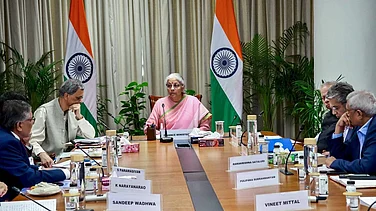The Reserve Bank of India (RBI) raised its inflation forecast on Friday for this fiscal year to 4.8 per cent from earlier 4.5 per cent given the slower decline in food inflation and sluggish demand. RBI Monetary Policy Committee (MPC) anticipates that high food prices will keep overall inflation elevated during the October-December quarter as well.
"The estimates of record kharif production should bring relief to elevated prices of rice and tur dal in particular," RBI governor Shaktikant Das said.
He noted that a good rabi season is also crucial for softening food inflation pressure. Das also highlighted that not only increasing food prices but geopolitical disruption also affected the global supply chain.
MPC believes that inflation for 3rd and 4th quarters of this FY will stand at 5.7 per cent and 4.5 per cent, respectively. Earlier, both were projected at 4.8 per cent and 4.2 per cent respectively.
With a 4:2 majority, MPC kept the repo rate unchanged for the 11th consecutive time. This decision could signal a cautious measure to balance inflation and economic growth as well as that RBI's main priority is to bring inflation under its 4 per cent target (with a leeway of 2 percentage points on either side).
The growth rate of world's fifth-largest economy slumped to a seven-quarter low in the September quarter and retail inflation in the country reached a 14-month high of 6.2 per cent in October, majorly driven by rising food prices.
Ahead of today’s decision announcement, CRISIL data revealed that the cost of home-cooked vegetarian thalis rose by 7.2 per cent year-on-year, while non-vegetarian thalis saw a 1.8 per cent increase, as per The Economic Times.
Weather and Food Inflation
According to India Meteorological Department (IMD), the country witnessed of the heaviest rainfall this year since 2020. It said rainfall from June to September reached 107.6% of the long-period average. Delayed monsoon withdrawal in September further led to excess rainfall, which eventually caused significant damage to key summer crops including rice, cotton, soybeans, corn, and pulses in several regions.
For its winter forecast of December 2024-February 2025, IMD predicted above-normal minimum and maximum temperatures in most parts of the country. It could affect the growth of winter crops including wheat, rapeseed, and chickpea.
If the impact is larger then lower production could force India to import these items to meet population demand, which could drive the prices higher. Hot and unseasonably warm weather already hit India's wheat output in 2022 and 2023, leading to a sharp drawdown in state reserves.
Das in his speech also noted that Das noted that increasing incidents of weather events, financial volatility and geopolitical developments pose upside risks to inflation.
"High inflation reduces the disposable income in the hands of consumers," Das added.
Revision of Food Item Weightage
As per reports, the government is likely to reduce the weightage of food items in the consumer price index (CPI) basket by 6.5 percentage points in rural areas and 3.4 percentage points in urban areas and revise the base year of the inflation series to deal with the rising inflation.
"Reducing weight to food items in consumer price index is a right decision," said Chokkalingam G, founder of the Equinomics Research Private Limited.
He also added that food inflation can be contained only by appropriate policies, incentives to increase crop output and resorting to considerable imports of price-sensitive crop outputs.
However, Indranil Pan, chief economist at Yes Bank, holds a different view on the matter.
“If it (revision of food items weightage) happens then, it will likely get redistributethe d in core where prices are comparatively stickier. So if the weightage increases there then why should I be expecting that the core inflation will come down,” Pan said.



























